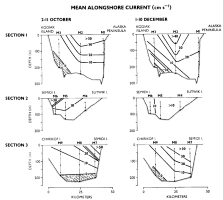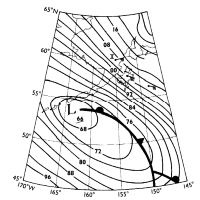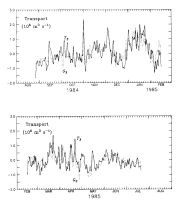U.S. Dept. of Commerce / NOAA / OAR / PMEL / Publications
Volume transport in the Alaska Coastal Current
James D. Schumacher, Phyllis J. Stabeno, and Andrew T. Roach
NOAA/Pacific Marine Environmental Laboratory, Seattle, Washington
Continental Shelf Research, 9(12), 1071-1083 (1989)
Not subject to U.S. copyright. Published in 1990 by Pergamon Press.
Discussion
Forcing mechanisms
The primary cause of the annual variation in transport in the ACC is the freshwater
runoff whose maximum occurs in autumn (Schumacher
and Reed, 1980; Royer,
1981, 1982).
The major source of this runoff is along the east and north coast of Alaska,
before the ACC enters Shelikof Strait. Estimates of geostrophic transport based
on CTD data from 20 occupations of seven stations along section 1 and collected
between March 1985 and June 1988 yield a mean and standard deviation of 0.59
± 0.32 × 10 m
m s
s . The reference levels used for geostrophic
transport calculations vary across the section (Reed
and Schumacher, 1989; Fig. 2). There were
no CTD surveys during winter. The maximum of 1.18 × 10
. The reference levels used for geostrophic
transport calculations vary across the section (Reed
and Schumacher, 1989; Fig. 2). There were
no CTD surveys during winter. The maximum of 1.18 × 10 m
m s
s occurred
in October 1985. The mean and standard deviation compares favorably with values
estimated from current records:
occurred
in October 1985. The mean and standard deviation compares favorably with values
estimated from current records: 
 = 0.81 ± 0.59 × 10
= 0.81 ± 0.59 × 10 m
m s
s , or
, or 
 = 0.85 ± 0.68 × 10
= 0.85 ± 0.68 × 10 m
m s
s .
.
There was also good agreement between calculated and observed transport over
shorter time intervals. From 25 to 26 March 1985, CTD data were collected at
stations along sections 2 and 3, providing estimates of 0.01 × 10 and 0.85 × 10
and 0.85 × 10 m
m s
s , respectively. (For the same time, current
data were used to establish a 190-dbar level of no motion for section 3.) From
current records the values were 0.05 and 0.86 × 10
, respectively. (For the same time, current
data were used to establish a 190-dbar level of no motion for section 3.) From
current records the values were 0.05 and 0.86 × 10 m
m s
s , for
sections 2 and 3, respectively.
, for
sections 2 and 3, respectively.
Volume transport during October 1984 (Table
1) was enhanced by the maximum freshwater accumulation. Since there is no
hydrographic data, we examine the current structure (Fig.
5) and salinity from moored instruments. During October, the largest current
speeds and the greatest vertical shear occurred in the vicinity of moorings
6 and 7. This was accompanied by a marked increase in current speed and a decrease
in salinity of approximately 1 psu at moorings 4-7 in the upper 56 m of the
water column. Both of these changes are consistent with observations made in
autumn 1978 (Schumacher
and Reed, 1986). We conclude that strong vertical shear and a narrow band
of high speeds and marked decrease in salinity (as observed in October 1984)
are features of the enhanced geostrophic transport associated with the large
increase of freshwater which occurs during autumn.

Figure 5. Structure of the mean current for (a) 2-11 October and (b) 1-10
December 1984. Volume transport at section 1 was 1.4 × 10 (1.7 × 10
(1.7 × 10 ), for section 2, 0.4 × 10
), for section 2, 0.4 × 10 (0.5 × 10
(0.5 × 10 ) and section 3, 1.0 × 10
) and section 3, 1.0 × 10 (1.3 × 10
(1.3 × 10 ) m
) m s
s for the October (December) event.
for the October (December) event.
Contrast these characteristics with those occurring during a transport pulse
of similar magnitude that occurred in December (Fig.
5). At section 1 the higher current speeds occurred over a greater area
than in October, with strong near-bottom flow toward the northeast compensating
for increased southwestward flow. In section 2, the maximum current was near
mooring 4 rather than at mooring 6, and both here and in section 3 vertical
shear markedly decreased from values in October. Finally, there was no accompanying
decrease in salinity at any mooring. The remaining three pulses had characteristics
similar to those in December and represent fluctuations which were not directly
related to the seasonally varying flux of freshwater.
Most of the remaining fluctuations were most likely caused by wind forcing.
Early studies (Schumacher
and Reed, 1980; Royer,
1981; Reed
and Schumacher, 1981) suggest that the alongshore component of the wind
alters the cross-shelf distribution of mass and perturbs coastal sea level through
Ekman transport. In the vicinity of Kodiak Island, complex wind patterns result
from the interaction of storms with orography. Within the orographically bounded
region of Shelikof Strait proper, nearshore isopycnal surfaces appear to be
deepened through differential Ekman pumping (Reed
and Schumacher, 1989). This causes large, rapid perturbations (about 0.4
× 10 m
m s
s in <3 days) in volume transport.
in <3 days) in volume transport.
Because most of the sea valley is nearly parallel to and in close proximity
of the coast, Ekman-driven coastal convergence should be important. Between
September 1984 and January 1985, estimates of coherence (at the 95% level of
significance) between the alongshore component (240°T) of the surface wind at
Semidi Islands and water transport accounted for 39, 3 and 41% of the fluctuations
in volume transport at sections 1, 2 and 3, respectively. For the series T approximately 45% (50% for the 11-month time interval) of the variance in transport
could be explained by the alongshore wind.
approximately 45% (50% for the 11-month time interval) of the variance in transport
could be explained by the alongshore wind.
Wind data collected from a research aircraft show convergence of geostrophic
and ageostrophic winds in the region between sections 1 and 2 (Macklin
et al., 1984). Under such meteorological conditions transport will
be enhanced toward the southwest in Shelikof Strait. At the same time, over
the open shelf west of Kodiak Island, onshore winds cause reduced transport
out of the system. As a result sea level increases in the region bounded by
the three sections. For example, between 30 October and 2 November 1984, an
eastward-moving low pressure system passed within 250 km south of the study
area. The distribution of surface atmospheric pressure (Fig.
6) caused onshore surface (geotriptic) winds over the open shelf and down-gradient
(ageostrophic) winds in Shelikof Strait proper. Concomitant with the storm,
near-surface currents at moorings 5-7 reversed and those at mooring 1 increased
toward the southwest. As a result, transport through section 2 decreased markedly
(<0.02 × 10 m
m s
s ), transport through section 3 was reduced
and it increased through section 1. At all bottom pressure gauges the response
was an increasing positive anomaly (>15 mbar), with a maximum occurring after
about 36 h. As the storm moved eastward, wind forcing changed and the convergence
of water transport ceased. As the dome of water relaxed, transport seaward through
section 3 increased by as much as 4.3 times greater than the mean. Volume transport
then reversed at all locations as the system overshot equilibrium. The interaction
is reversible. A high pressure system southwest of the Shelikof region generates
offshore winds over the open shelf and northeastward winds in Shelikof Strait
which result in divergent transport. The strong reversal of transport which
occurred at the start of the time series in August is an example of such an
event.
), transport through section 3 was reduced
and it increased through section 1. At all bottom pressure gauges the response
was an increasing positive anomaly (>15 mbar), with a maximum occurring after
about 36 h. As the storm moved eastward, wind forcing changed and the convergence
of water transport ceased. As the dome of water relaxed, transport seaward through
section 3 increased by as much as 4.3 times greater than the mean. Volume transport
then reversed at all locations as the system overshot equilibrium. The interaction
is reversible. A high pressure system southwest of the Shelikof region generates
offshore winds over the open shelf and northeastward winds in Shelikof Strait
which result in divergent transport. The strong reversal of transport which
occurred at the start of the time series in August is an example of such an
event.

Figure 6. Sea level atmospheric pressure for 1200 on 31 October 1984. The
wind barbs are actual observations. Note how the barb at Iliamna (labeled I)
indicates down-gradient winds similar to those in Shelikof Strait. Surface wind
at Semidi Island was 12.5 m s toward 300°T.
toward 300°T.
The integrated effect of storms also accounts for variations in volume transport
over longer time intervals. Data on principal tracks of centers of cyclones
at sea level (Mariner's
Weather Log, 1985) provide necessary information to estimate the possible
impact of storms. During January, five cyclones passed through the region bounded
by 50°-55°N, and 155°-165°W, on trajectories from south to north. During February,
only two storms passed through the southernmost portion of the area and they
were on eastward trajectories. The difference in number and trajectory of these
storms was reflected in the mean alongshore wind component (240°T) which reversed
from 5.2 m s in January to -0.2 m s
in January to -0.2 m s in February. Accompanying the difference in storm characteristics was a marked
difference between the monthly transport in January (1.74 × 10
in February. Accompanying the difference in storm characteristics was a marked
difference between the monthly transport in January (1.74 × 10 m
m s
s ) and
February (0.59 × 10
) and
February (0.59 × 10 m
m s
s ).
).
Geostrophy
One of the objectives of the field experiment was to determine if bottom pressure
measurements could be used to calculate transport. Following Brown
et al. (1987), fluctuations in transport are related to bottom pressure
via
 (1)
(1)
where x is the across-channel direction, G the geostrophic transport,
p the bottom pressure, 
 mean density, f Coriolis and h(x) depth. We have neglected
the two terms representing density anomalies, since the time series of salinity
and temperature were not complete enough to calculate density. Bottom pressure
records were limited to the endpoints of each section, so we assume that h(x)
= H, a constant. Deviation from this assumption was greatest at section 1 (30%)
and least at section 3 (<10%). The correlations of transports with their
associated pressure differences at sections 2 and 3 accounted for 50 and 62%
of transport fluctuations, respectively. At section 1 there was no significant
correlation. This was probably caused by two factors. The first is the deviation
of h(x) from constant value; the second is the strength of density
anomalies which are largest at section 1 since it is nearer the freshwater sources.
mean density, f Coriolis and h(x) depth. We have neglected
the two terms representing density anomalies, since the time series of salinity
and temperature were not complete enough to calculate density. Bottom pressure
records were limited to the endpoints of each section, so we assume that h(x)
= H, a constant. Deviation from this assumption was greatest at section 1 (30%)
and least at section 3 (<10%). The correlations of transports with their
associated pressure differences at sections 2 and 3 accounted for 50 and 62%
of transport fluctuations, respectively. At section 1 there was no significant
correlation. This was probably caused by two factors. The first is the deviation
of h(x) from constant value; the second is the strength of density
anomalies which are largest at section 1 since it is nearer the freshwater sources.
For section 3, the geostrophic transport was calculated using equation (1)
with 
 = 1 g cm
= 1 g cm , f = 1.23 × 10
, f = 1.23 × 10 and H = 205 m. Shown in Fig. 7 are the demeaned
and detrended transports, calculated from the velocity records (T
and H = 205 m. Shown in Fig. 7 are the demeaned
and detrended transports, calculated from the velocity records (T ) and the geostrophic relationship (G
) and the geostrophic relationship (G ).
The fluctuations calculated using equation (1) were nearly of the same magnitude
as those observed; a least squares fit of T
).
The fluctuations calculated using equation (1) were nearly of the same magnitude
as those observed; a least squares fit of T =
=  G
G + e yields
+ e yields  = 0.94. The balance held
for many of the strong pulses, at both short and long periods and for both in-
and outflow events. Except at a period of 10 days, the series were coherent
(at the 95% level) and the phase did not differ significantly from zero. The
relationship between bottom pressure difference and transport at section 2 was
similar to the results at section 3.
= 0.94. The balance held
for many of the strong pulses, at both short and long periods and for both in-
and outflow events. Except at a period of 10 days, the series were coherent
(at the 95% level) and the phase did not differ significantly from zero. The
relationship between bottom pressure difference and transport at section 2 was
similar to the results at section 3.

Figure 7. The demeaned and detrended time series of transport through section
3 from current records (T ,
solid line) and from the bottom pressure records from moorings 7 and 9 (G
,
solid line) and from the bottom pressure records from moorings 7 and 9 (G ,
dotted line).
,
dotted line).
Go back to previous section or
forward to next section
PMEL Outstanding Papers
PMEL Publications Search
PMEL Homepage
 m
m s
s . The reference levels used for geostrophic
transport calculations vary across the section (Reed
and Schumacher, 1989; Fig. 2). There were
no CTD surveys during winter. The maximum of 1.18 × 10
. The reference levels used for geostrophic
transport calculations vary across the section (Reed
and Schumacher, 1989; Fig. 2). There were
no CTD surveys during winter. The maximum of 1.18 × 10 m
m s
s occurred
in October 1985. The mean and standard deviation compares favorably with values
estimated from current records:
occurred
in October 1985. The mean and standard deviation compares favorably with values
estimated from current records: 
 = 0.81 ± 0.59 × 10
= 0.81 ± 0.59 × 10 m
m s
s , or
, or 
 = 0.85 ± 0.68 × 10
= 0.85 ± 0.68 × 10 m
m s
s .
. 

 (1)
(1)

 mean density, f Coriolis and h(x) depth. We have neglected
the two terms representing density anomalies, since the time series of salinity
and temperature were not complete enough to calculate density. Bottom pressure
records were limited to the endpoints of each section, so we assume that h(x)
= H, a constant. Deviation from this assumption was greatest at section 1 (30%)
and least at section 3 (<10%). The correlations of transports with their
associated pressure differences at sections 2 and 3 accounted for 50 and 62%
of transport fluctuations, respectively. At section 1 there was no significant
correlation. This was probably caused by two factors. The first is the deviation
of h(x) from constant value; the second is the strength of density
anomalies which are largest at section 1 since it is nearer the freshwater sources.
mean density, f Coriolis and h(x) depth. We have neglected
the two terms representing density anomalies, since the time series of salinity
and temperature were not complete enough to calculate density. Bottom pressure
records were limited to the endpoints of each section, so we assume that h(x)
= H, a constant. Deviation from this assumption was greatest at section 1 (30%)
and least at section 3 (<10%). The correlations of transports with their
associated pressure differences at sections 2 and 3 accounted for 50 and 62%
of transport fluctuations, respectively. At section 1 there was no significant
correlation. This was probably caused by two factors. The first is the deviation
of h(x) from constant value; the second is the strength of density
anomalies which are largest at section 1 since it is nearer the freshwater sources.
 , f = 1.23 × 10
, f = 1.23 × 10 and H = 205 m. Shown in
and H = 205 m. Shown in  ) and the geostrophic relationship (G
) and the geostrophic relationship (G G
G